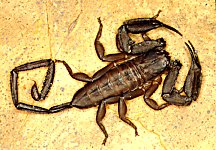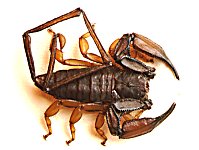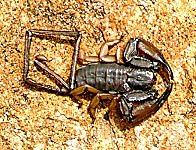|
Genus: Hadogenes (flat rock scorpions)
Life
> Eukaryotes
>
Opisthokonta >
Metazoa
(animals) > Bilateria > Ecdysozoa > Panarthropoda > Tritocerebra >
Arthropoda > Arachnomorpha > Cheliceriformes > Chelicerata > Euchelicerata
> Arachnida > Scorpiones
(scorpions)
> Superfamily: Scorpionoidea
> Family: Liochelidae
Hadogenes is a southern African endemic (occurs
nowhere else) with species occurring in South Africa, Namibia, Botswana,
Zimbabwe and Mozambique. There are currently 18 described species with more in
preparation.
Hadogenes is lithophilous
occurring in rocky habitats, retreating into rock crevices or under exfoliated
rock. Their feet are adapted with special claws on the tarsus to enable it to
grip and climb over its rocky habitat. Hadogenes is very habitat specific
occurring in hot arid rock outcrops and, being unable to navigate over open
stretches of sand, tends to speciate. Different species can often be found on
different outcrops within 2 kilometres of each other. Experiments have
illustrated that if a Hadogenes is moved more than 10 metres from its
habitat it takes a few days to return. If the translocation is less than 7,5
metres it will return that same night. If the sand to be crossed is too
extensive it will perish in the heat.
Hadogenes is dark brown and the legs are lighter in
colour. The body and chelae are extremely flattened dorsoventrally and the legs
and very thin tail are flattened laterally The tail and legs are of a similar
thickness, the legs being weak and rarely used. The tail length is 60% to 200%
of the trunk (combined prosoma and mesosoma). They vary in size from the small
Hadogenes lawrenci (50 mm) to Hadogenes troglodytes, the world’s
longest scorpion that attains a body length of 210 mm, and weighing up to 32
grams.
Hadogenes is threatened in certain areas due to
habitat destruction for the quarry stone industry, urban development and the
collection for the international pet trade. Two species, H. troglodytes and
H. granulatus, are currently available in the pet trade. Fortunately those
species occurring in conservation areas are offered greater protection.
Species indigenous to southern Africa
Two of the 15 species are featured below plus one
unidentified species.
| Hadogenes
minor The only species in
the Western Cape occurring in the Cedarberg. This scorpions future is secure
as most of the greater Cedarberg will soon be protected in a very extensive
conservancy streatching from the west coast to the Tankwa National Park in
the east and northwards to Oorlogskloof Nature Reserve at Nieuwoudtville in
the Northern Cape. |
 |
| Hadogenes gracilis
This scorpion has a very restricted
range among some rocky outcrops in Mapumalanga and is threatened with extinction
because of mining destroying its habitat. |
 |
| Hadogenes sp. |
 |
Text by
Norman Larsen © |
